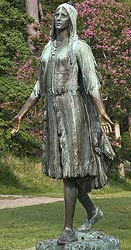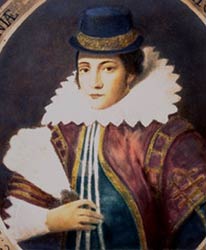(c. 1595 – March 21 1617)

Pocahontas was the daughter of Powhatan (also known as Wahunsenacawh), the powerful chief of the Algonquian Indians in the Tidewater region of Virginia. She was born around 1595 and was named Matoaka, though she is better known as Pocahontas, which means “Little Wanton,” a playful, frolicsome child. She married an Englishman, John Rolfe, and became a celebrity in London in the last year of her life. After her baptism, she went by the name Rebecca and upon her marriage to Rolfe, she became known as Lady Rebecca.
In April 1607, when the English colonists arrived in Virginia and began building settlements, Pocahontas was around the age of 12-14 years old. A leading colonist, John Smith, recounted that he was captured by a group of Powhatan hunters and brought to Werowocomoco, one of the chief villages of the Powhatan Empire. He said he was laid across a stone and was about to be executed, when Pocahontas threw herself across his body to save his life. This version was met with skepticism due to conflicting dates in his historical accounts; some experts suggested that the “rescue” was part of a Powhatan ritual although there is no evidence for any similar rituals among other North American tribes.
Regardless, this encounter initiated a friendship with Smith and the Jamestown colony, and Pocahontas along with a few of her brothers, would often come to the settlement to play. She also brought the settlers provisions to stave off winter hunger. As the colonists expanded further, however, some of the Native Americans felt their lands were threatened, and conflicts arose again.
Association with John Smith
In 1608, Pocahontas is said to have saved Smith a second time. Smith and some other colonists were invited to Werowocomoco by Chief Powhatan on friendly terms. They were treated kindly and traded with the Indians, but missed the tide and had to spend the night. That night, Pocahontas came to Smith’s hut and told him that her father was planning to send men with food who would kill them when they put down their weapons to eat. She had been told not to inform them, but she begged the Englishmen to leave. The English kept their weapons close by them even while eating, and no attack came.
In 1609, an injury from a gunpowder explosion forced Smith to return to England for medical care. The English told the natives Smith was dead after being captured and taken aboard a French pirate ship. The ship then had been wrecked on the Brittany coast, and it had gone down with all hands Pocahontas believed Smith was dead until she arrived in England several years later, the wife of John Rolfe.
In March 1613, Pocahontas was residing at Passapatanzy, a village of the Patawomecks, a Native American tribe that did some trading with Powhatans. They lived on the Potomac River near Fredericksburg, about 65 miles from Werowocomoco. She was captured by two English colonists, and held for ransom in exchange for some English prisoners held by Chief Powhatan, along with various weapons and tools the Powhatans had stolen. Powhatan returned the prisoners, but not the weapons until a long standoff ensued.
During the year-long wait, Pocahontas was kept at Henricus, in modern-day Chesterfield County, Virginia. While there, an English minister taught her about Christianity and helped to improve her English. After she was baptized, her name was changed to Rebecca.
In March 1614, the standoff built to a violent confrontation between hundreds of English and Powhatan men on the Pamunkey River. The English permitted Pocahontas to talk to her countrymen; however, according to the deputy governor, Thomas Dale, Pocahontas was upset that her father had not been among the senior chiefs sent to do battle with the English. As a result, she claimed that if she were to be valued “less than old swords, pieces, or axes” that she would prefer to live with the English.
Marriage to John Rolfe
During her stay in Henricus, Pocahontas met John Rolfe, a successful tobacco farmer, whose English-born wife had died. John Rolfe was a very religious man who agonized over the decision to marry a “strange wife,” a heathen Indian. He finally decided to marry Pocahontas after she had been converted to Christianity, “for the good of the plantation, the honor of our country, for the glory of God, for mine own salvation …” Pocahontas was baptized and christened Rebecca. She married John Rolfe on April 5, 1614. A general peace and a spirit of goodwill between the English and the Indians resulted from this marriage.
For a few years after the marriage, the couple lived together at Rolfe’s plantation, Varina Farms, which was located across the James River from the new community of Henricus. They had a child, Thomas Rolfe, born on January 30, 1615. Their marriage did not win back the English captives, but it created a climate of peace between the Jamestown colonists and Powhatan’s tribes for several years.
 England and Death
England and Death
The Virginia Colony’s sponsors found it difficult to lure new colonists and investors to Jamestown. They used Pocahontas as an enticement and as evidence to convince people in Europe that the New World’s natives could be tamed.
In June 1616, the Rolfes traveled to England, arriving at the port of Plymouth on the June 12th. They were accompanied by a group of around eleven other Powhatan natives including Tomocomo, a holy man. John Smith was living in London at the time, and in Plymouth, Pocahontas learned he was still alive. Smith did not meet Pocahontas at this point, but he wrote a letter to Queen Anne urging Pocahontas be treated with respect. And so she was. The arrival of Pocahontas in London was well publicized and while there is no evidence that Pocahontas was formally presented to King James and his court, she was introduced to him at a ball, and she met the best of London’s high society.
In March 1617, Rolfe and Pocahontas boarded a ship to return to Virginia. But she had only had only gotten as far as Gravesend on the River Thames when she became ill. She was taken ashore and died. Pneumonia or tuberculosis were likely causes, although smallpox had also been suggested. Her funeral took place on March 21, 1617 and she was buried in a churchyard in Gravesend, England. She was 22 years old. Pocahontas is commemorated there with a life-size bronze statue at St George’s Church.
Descendants
Pocahontas and Rolfe had one child, Thomas Rolfe, who was born in Virginia in 1615 before his parents left for England. Through this son Pocahontas has many descendants. Many First Families of Virginia trace their roots to Pocahontas and Chief Powhatan, including such notable individuals as Edith Wilson, wife of Woodrow Wilson; George Wythe Randolph; Admiral Richard Byrd; Virginia Governor Harry Flood Byrd; fashion-designer and socialite Pauline de Rothschild; former First-Lady Nancy Reagan; and astronomer and mathematician Percival Lowell.





